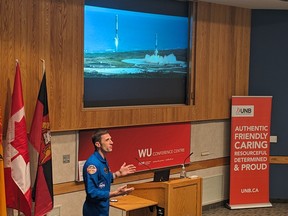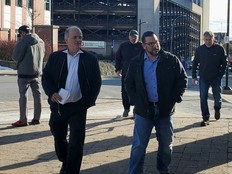'Buckle up, hang on, get excited,' astronaut tells UNB students ahead of launch
Joshua Kutryk has been preparing in the deep ocean, desolate canyons and beyond for the Starliner-1 launch in 2025

Article content
A long road of physical and mental training will culminate in a milestone trip to space for Canadian Space Agency astronaut Joshua Kutryk, who visited Fredericton on Tuesday to address university students.
His six-month assignment to Starliner-1 in 2025 will mark the first time a Canadian astronaut takes part in the National Aeronautics and Space Administration’s commercial manned mission program.
Kutryk said the goal of the mission will be to dock with the International Space Station, go aboard and spend six or seven months working there, before returning to Earth.
“This has to be seen as a crowning achievement of humanity, frankly. What humans can do when they really try to do something, when they collaborate instead of compete, when they prioritize properly,” he said.
Canada’s main contribution to the project has been in robotics, he said, but his day-to-day job will involve operating the station, performing hardware maintenance and repairs, and working in the laboratory.
“We have to be experts on that ginormous international space station, which is from my perspective one of the most complex things ever invented,” he said.
“We do unique, one-of-a-kind science there that cannot be done anywhere else because, of course, the microgravity environment.”
The 41-year-old from Alberta said the mission is considered high risk, speaking with reporters after an event at the University of New Brunswick.
“It’s going to be exciting, it’s going to be a little bit scary of course,” he said. “This will be only the second time this thing has gone to space with humans on board. So it is high risk, and that’s not lost on us.”
But he’s well-suited to the task, having clocked over over 4,000 hours of flight experience on over 40 aircraft types as an experimental test pilot, fighter pilot, civil and military flight instructor, among other roles.
However, Kutryk said, his passion is also well-aligned with the Starliner-1 mission.
“There’s nothing I’d rather be doing than what I’m doing, which is the first flight of a vehicle,” he said, addressing a packed room at UNB’s Fredericton campus.
“If you’re doing a test flight on Earth or you’re doing a test flight in space, you’re operating highly complex machinery in an environment where you can’t make a mistake. High risk, high consequence.”
The mission is also risky because of its longer duration, the astronaut added.
“The space environment is very bad for us. It’s an environment that takes away our bone mass, our muscle mass, it affects our brains, our cardiovascular system,” he said.
“It’s like taking the aging process and hitting triple fast forward … We spend a lot of time pre-mission, in mission and post-mission working on our body to try to make sure we’re getting back to normal – to be able to walk again, for example.”
Kutryk will embark on the high-profile mission early in his career as an astronaut, having been certified after a two-year candidate training program in January 2020.
On top of physical training, Kutryk said preparation has involved several simulations – from landing the vehicle in water to testing out the seat he will use during the launch.
The four-person Starliner-1 team has also travelled deep down into caves, ventured to the ocean floor, and flown into isolated canyons to complete “space analog” missions.
“The real point with all of them is to practise team skills,” he said. “Team skills, particularly when you are in dangerous environments that are extremely isolated, which is what space is, are not something that come easy.”
While Kutryk has spent seven months away from home, he’s never spent that long in outer space. He and other team members will be allowed a shoebox to fill with objects that remind them of home.
“It just stays right beside us and it’s with us for the whole expedition,” he said.
A pocket watch from his dad will be among the items that Kutryk takes with him on Starliner-1.
“It’s not even that old, it’s probably just over 100 years old. But if you think about that for a minute, just that few years ago, where I’m from in Alberta, there was no electricity, people living in log cabins,” he said.
“They had stopwatches like this, and now that stopwatch is going to go to space with me. And it’s intriguing for me to think about that, how far we’ve come in just a couple generations, 100 years … it’s really interesting if you think about where we could be 100 years from now.”












Postmedia is committed to maintaining a lively but civil forum for discussion. Please keep comments relevant and respectful. Comments may take up to an hour to appear on the site. You will receive an email if there is a reply to your comment, an update to a thread you follow or if a user you follow comments. Visit our Community Guidelines for more information.